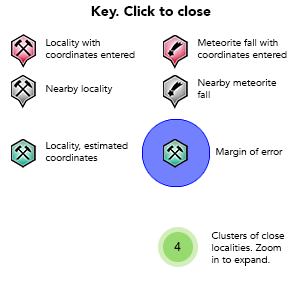Royal Standard Mine, Wharekirauponga, Hauraki District, Waikato Region, North Island, New Zealand

| Latitude & Longitude (WGS84): | 37° 17' 29'' South , 175° 49' 39'' East |
|---|---|
| Latitude & Longitude (decimal): | -37.29140,175.82769 |
| GeoHash: | G#: rcm5c53cf |
| Locality type: | Mine |
| Köppen climate type: | Cfb : Temperate oceanic climate |
Au-Ag deposit. Historic mine site.
Located in a deep gorge in the upper Wharekirauponga Stream, 11 kilometres south-west of Whangamata.
The Royal Standard Gold Mining Company was formed in London in 1896, with the intention to amalgamate several prospecting claims in the area. Much money was then spent building a tramway from the mine 8 kilometres to the ocean, erecting a water race, several houses, and purchasing a battery. Around 197 men were employed during this period.
Investors from far away England were in fact having their money squandered, as little attempt had been made to verify how much gold was in the deposit. A new manager, and the financial officer were sent from England to check on progress, and quickly brought things to a halt. The site was sold at auction in 1899.
The battery had been transported to the site, but never erected, and remained in pieces scattered around the location. In the early 1970's, Glen Mayfair of Waihi applied to the New Zealand Forest Service to remove the machinery for his own private battery. Approval was given, and a track bulldozed in to remove the machinery. Mayfair later gave it back to this government department who stored the pieces at the old Victoria battery ruins near Waikino. The Royal Standard relics were subsequently removed from this site illegally, and never recovered.
In the late 1890's, the deposit was described as white soft kaolinite with low grade gold values, with floating barren quartz lenses within it. A modern study (Rabone, 1989) is a little more positive about the value of the quartz veins.
A quartz vein stock work is hosted by intensely hydrothermally altered flow banded and spherulitic mid Pliocene aged rhyolite and tuffs of the Whitianga Group.
There is a central core of silicified rhyolite, with zoned alteration around it of quartz-adularia-retrograde illite 50 metres wide, elongated north-south 450 metres. This gives way at depth to a propylitic assemblage, with chlorite and minor adularia. The quartz-adularia zone is bounded to the south by interlayered illite-montmorillonite partly peripheral, and partly overprinting the quartz-adularia. There is an upper acid leach zone consisting of cristobalite, kaolinite and montmorillonite. Gold values decrease with depth.
Au-Ag is found extensively within the margins of this central zone silification. Most of the mineralisation is hosted in the veins, however it is widespread also as low values in the host rhyolite. There are simple and complex veins, with gold only found in the complex veins. These veins consist of multiphase banded, granular, fibrous, drusy and chalcedonic quartz, rare rhombic adularia, and pyritic and limonite bands. These bands may contain trace arsenopyrite, chalcopyrite, secondary covellite, digenite, and hematite. Gold is found in the bands as clusters of sub-microscopic grains free, or in pyrite, chalcopyrite or limonite.
The site can be accessed by a walking track from the end of the Parakiwai Quarry Road. The track follows the old tram line, and is said to be muddy in places. Some machinery relics remain scattered about, and several overgrown adits. There is a waterfall further along the track but this section is said to be steep and slippery.
Mineral List
13 valid minerals.
Rock Types Recorded
Select Rock List Type
Alphabetical List Tree DiagramRegional Geology
This geological map and associated information on rock units at or nearby to the coordinates given for this locality is based on relatively small scale geological maps provided by various national Geological Surveys. This does not necessarily represent the complete geology at this locality but it gives a background for the region in which it is found.
Click on geological units on the map for more information. Click here to view full-screen map on Macrostrat.org
| Quaternary 0 - 2.588 Ma ID: 3187411 | Cenozoic volcanic rocks Age: Pleistocene (0 - 2.588 Ma) Lithology: Ignimbrite(s); felsic volcanic rocks; rhyolite Reference: Chorlton, L.B. Generalized geology of the world: bedrock domains and major faults in GIS format: a small-scale world geology map with an extended geological attribute database. doi: 10.4095/223767. Geological Survey of Canada, Open File 5529. [154] |
| Messinian - Tortonian 5.333 - 11.62 Ma ID: 1332446 | Waiwawa Subgroup andesite and dacite (Coromandel Group) of Coromandel Volcanic Zone Age: Miocene (5.333 - 11.62 Ma) Stratigraphic Name: Waiwawa Subgroup Description: Andesite, dacite and rhyodacite flows and domes with intercalated tuff, tuff breccia and volcaniclastic sediments. Local, non--welded, dacitic, pumice-rich ignimbrite. Comments: Neogene igneous rocks. Age based on K-Ar Lithology: Major:: {andesite},Minor:: {dacite, rhyodacite, tuff, breccia} Reference: Heron, D.W. . Geology Map of New Zealand 1:250 000. GNS Science Geological Map 1. [13] |
| Miocene 5.333 - 23.03 Ma ID: 1308094 | Coromandel Group Miocene andesite and basaltic andesite lava Age: Miocene (5.333 - 23.03 Ma) Stratigraphic Name: Coromandel Group Description: Andesite and basaltic andesite lava, tuff and tuff breccia, agglomerate and pyroclastic flow deposits; andesite, diorite and dacite dikes and subvolcanic intusions. Comments: Zealandia Megasequence Extrusive and Intrusive Rocks (Neogene) Lithology: Andesite, tuffite, tuff-breccia, agglomerate, pyroclastic material, andesite, diorite, dacite Reference: Edbrooke, S.W., Heron, D.W., Forsyth, P.J., Jongens, R. (compilers). Geology Map of New Zealand 1:1 000 000. GNS Science Geological Map 2. [12] |
Data and map coding provided by Macrostrat.org, used under Creative Commons Attribution 4.0 License
References
External Links
http://www.doc.govt.nz/parks-and-recreation/places-to-go/coromandel/places/coromandel-forest-park/things-to-do/wharekirauponga-track/



